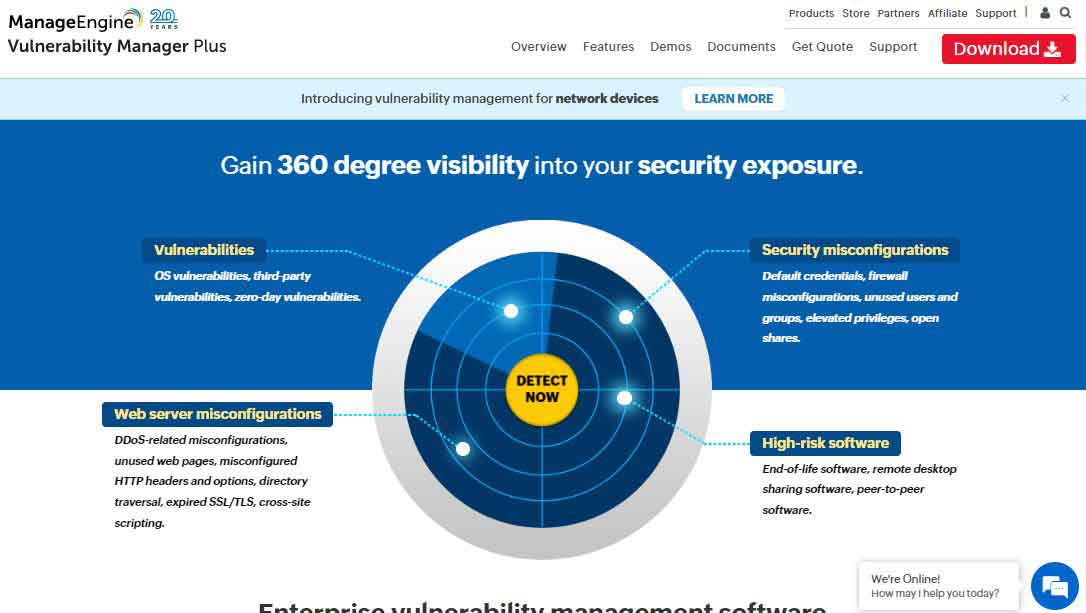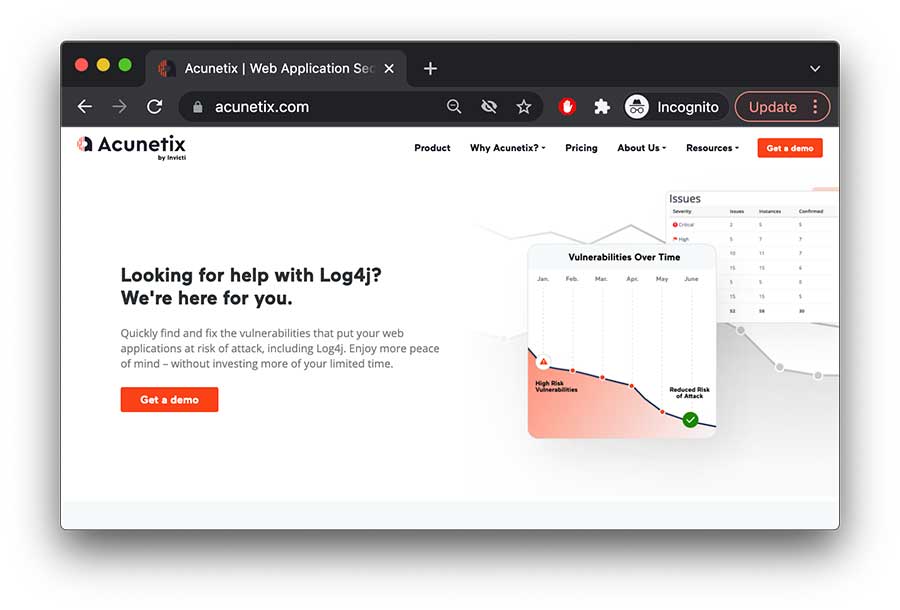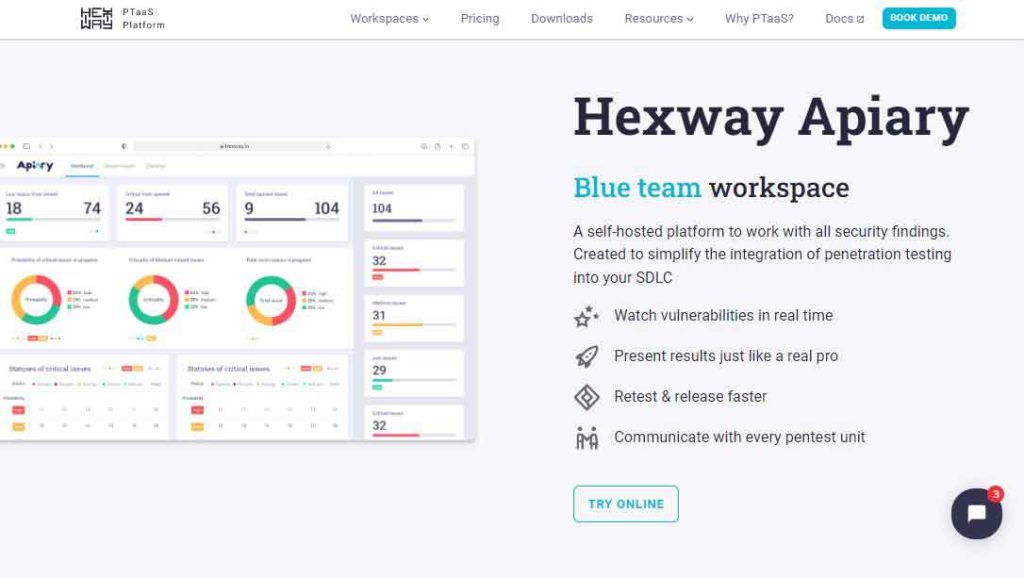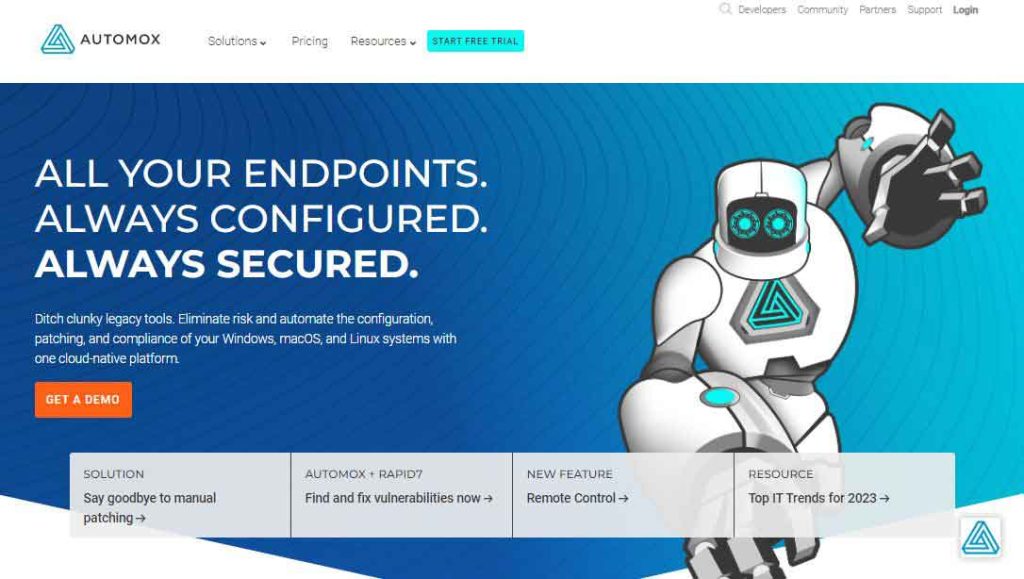Vulnerability management tools scan and detect weaknesses within the network that hackers can exploit. Using such a tool is essential to maintain business integrity and prevent data breaches and the risk of cyber attacks. Check out the following list of the 19 best vulnerability management software that are worth trying in 2024:
- OpenVas – It identifies vulnerabilities in an app’s feed containing approximately 50,000 texts and updates daily.
- Intruder – It detects a wide range of vulnerabilities like missing patches, misconfigurations, application bugs, weak encryption, and other weaknesses
- Harness – The tool automatically runs the desired security scans at the appropriate pipeline stage to deliver secure applications
- ThreadFix – It applies DevOps concepts for continuous vulnerability scanning and detects, organizes, prioritizes, and speeds up the security processes.
- Rapid7 Insight VM – Supports a proactive approach to vulnerability management with tracking and metrics that recommends remediations to fix the issues immediately.
- Kenna Security – It uses advanced machine learning and data science techniques to analyze over 12.7 billion managed vulnerabilities.
- CrowdStrike Falcon Spotlight – The software uses a combination of AI processes and a threat intelligence database to detect vulnerabilities within a network.
- ImmuniWeb Discovery – It uses machine learning techniques to identify the weaknesses within the network and plays a crucial role in reducing the incidences of false-positive reporting.
- ManageEngine Vulnerability Manager Plus – Uses an advanced technology scanner that detects the network’s zero-day vulnerabilities.
- Nessus Professional – It continuously tracks and assesses known and unknown assets and their vulnerabilities and provides immediate insight through the dashboard for detailed analysis.
- Paessler Network Vulnerability Monitoring With PRTG – It scans the network with the IP address and uses a combination of packet sniffing, SNMP, and WMI to report on the network performance.
- Alert Logic MDR – It works across hybrid and public cloud environments to provide critical information on the security posture and identify threats that put business data at risk.
- Qualys VMDR – The tool has a centralized dashboard that provides comprehensive and real-time information about IT assets, so it’s easy to identify threats before they cause any harm.
- Astra Pentest – It offers a simple and clean interface with an interactive project dashboard that analyzes the vulnerabilities by showing the risk scores of each vulnerability and their impact on the business.
- Acunetix – It offers multiple scanning engines, increasing efficiency and ensuring an excellent user experience.
- SolarWinds Network Configuration Manager – It provides management and backup of all the network devices, thus minimizing the management of several devices
- Hexway Vampy – This network vulnerability tool gathers data from different sources and gives real-time insight into the vulnerabilities to take remediation steps instantaneously.
- Automax – It is a cloud-native platform that allows organizations to automate critical patching, security configurations, software updates, and custom scripting across various endpoints.
- Tripwire IP360 – It provides complete visibility into organizations’ on-premises and cloud environments.
Vulnerability Management is a continuous process designed to detect, classify, remediate, and mitigate vulnerabilities within an IT infrastructure to reduce organizational risk. Implementing vulnerability management practices is vital for organizations and requires vulnerability management software.
The software helps companies by scanning the entire network and discovering security flaws and weak points that intruders can exploit. Later, it fixes the vulnerabilities and enhances the organization’s overall security posture.
Several types of vulnerability management software exist, but not all are equal. The following guide combines the best vulnerability management software to help you find the right solution for your organization.
Why do you need vulnerability management software?
Hackers always look for vulnerabilities to exploit to access the network and compromise sensitive business data. Thus, organizations must use vulnerability management software to reduce risks and improve security posture.
The main function of vulnerability management software is to keep the business network safe from all known vulnerabilities and ensure that cybercriminals cannot easily target you. It detects, prioritizes, and remediates critical vulnerabilities before they can cause any harm.
Besides this, other reasons that signify the importance of using vulnerability management software are as follows:
- The software adds operational efficiency by reducing the manual workload and automating the process by continuous monitoring, alerting, and offering mitigation solutions.
- By detecting the vulnerabilities, the companies stay compliant with the regulatory standards, protect them from getting penalized, and thus save their reputation.
The threat vector increases as enterprises add new devices, cloud services, and applications to their network. To protect your company from these threats, it’s mandatory to use trusted vulnerability management software that can ensure maximum organizational security.
19 Best vulnerability management tools in 2024
The global security and vulnerability management software market will likely grow to $15.5 billion by 2025. Such drastic market growth is due to rising cyber-attacks and regulations for enterprises to follow mandatory regulatory compliance. Hence, it’s the right time if you haven’t started using any vulnerability management software for your company.
Below are the best vulnerability management software based on our research and multiple tests.
1. OpenVas

- Website URL: openvas.org
OpenVAS, also known as Open Vulnerability Assessment System, is a fully-featured vulnerability scanner that offers vulnerability scanning and management techniques. It is an easy-to-use tool with a user-friendly interface with dashboards that give details such as displaying the vulnerability list and its detailed view and give quick results. In addition, it identifies vulnerabilities in an app’s feed containing approximately 50,000 texts and updates daily.
One of the best things about OpenVAS is that a sizeable open-source community supports it, and it is free of charge. It’s free to use and gets regular updates, thus making it the best option for small to mid-sized organizations searching for inexpensive tools to discover vulnerabilities.
There is a paid version called Greenbone Vulnerability Management; however, getting the premium plan is challenging. The only downside of this tool is that it doesn’t support all operating systems and only runs on the Linux environment.
2. Intruder

- Website URL: intruder.io
Intruder is a top-rated online vulnerability scanner that publicly and privately scans websites, cloud systems, servers, and endpoint devices using the industry’s leading scanning engines. It also detects a wide range of vulnerabilities, such as missing patches, misconfigurations, application bugs, weak encryption, and other weaknesses within the digital infrastructure that cause data breaches.
The recently released Network View feature provides a more straightforward and updated picture of what attackers can see and what’s easily accessible to them that can put you at risk. The raw data taken from the scanning engines is prioritized for a holistic view, and quick action is taken to save time and reduce the attack surface.
The software is ideal for companies who want continuous vulnerability monitoring and receive a proactive response. It offers three premium subscription plans, but you can take advantage of the 14-day free trial period to check out all the pro features and decide whether it can ensure network security.
3. Harness

- Website URL: harness.io/products/security-testing-orchestration
To automate security testing and eliminate false positives, consider using the Security Testing and Orchestration tool, a significant service Harness offers. It automatically runs the desired security scans at the appropriate pipeline stage to deliver secure applications and minimizes the risk of potential misconfiguration and security flaws.
In addition, it allows the users to repeat the scans to detect risks without changing the existing workflows and offers instant remediations.
This vulnerability management tool is handy for app testing and is mainly used by DevOps or DevSecOps engineers. It offers free and paid versions, and the free plan is available to all customers, i.e., individual developers, start-ups, and mid and large-size organizations.
On the downside, the free plan offers limited monthly scans and doesn’t allow users to access certain advanced features. Upgrade to the team or enterprise plan to get complete access to all the features.
4. ThreadFix

ThreadFix is an excellent vulnerability management program that comprehensively views applications’ risks. It applies DevOps concepts for continuous vulnerability scanning and detects, organizes, and prioritizes the risks.
Instead of using a spreadsheet, it relies on advanced patented Hybrid Analysis Mapping (HAM) technology to eliminate the need to manually merge the results of static and dynamic testing activities using efficient tools. Besides this, the software integrates with over 40 different applications and network scanners to detect vulnerabilities, making it an efficient vulnerability management tool in the market.
ThreadFix is an advanced tool that offers a seamless vulnerability management experience and is best suited for businesses searching for comprehensive vulnerability management and reporting. The software doesn’t provide a trial version or a fixed pricing plan. You need to contact the customer support team and request a demo to try out its features and functionality.
5. Rapid7 Insight VM

- Website URL: rapid7.com/products/insightvm/
Insight VM is a robust cloud-based exposure management software built around the Rapid7 on-premises vulnerability scanning solution Nexpose. It enables security teams to run vulnerability scans across their entire environment (physical, virtual, and cloud environments) and automatically obtain data across all endpoints.
Also, it supports a proactive approach to vulnerability management with tracking and metrics that recommend remediation to fix the issues immediately.
Rapid7 InsightVM is the best tool for small to mid-sized organizations looking for end-to-end solid vulnerability management capabilities and integration with other endpoint security tools. It offers a paid subscription plan, but the prices are not fixed and depend on the number of assets covered. It also provides a free trial version, so interested people can use it and decide if it’s a good option.
6. Kenna Security

- Website URL: kennasecurity.com
Kenna Security is a pioneering vulnerability-controlling software that relies on threat intelligence and prioritization to help security teams focus on reducing the most significant business. It uses advanced machine learning and data science techniques to analyze over 12.7 billion managed vulnerabilities and exploit intelligence feeds and business data to uncover what attackers can benefit from.
The software’s risk scoring is the most impressive and unique feature that most others lack. The discovered vulnerabilities are scored between 0-1000, with 0-330 being the lowest risk, 331-660 in medium, and 660-1000 as high-risk vulnerabilities. Its predictive modeling technology is also an outstanding feature that predicts which vulnerabilities become weaponized and can risk overall security.
Organizations of all sizes can use this software to discover and remediate security issues. It is also a paid vulnerability management tool, but you can contact the sales team to start a free demo to check its functioning.
7. CrowdStrike Falcon Spotlight

- Website URL: crowdstrike.com/products/security-and-it-operations/falcon-spotlight-vulnerability-management
Falcon Spotlight is a vulnerability management tool offered by CrowdStrike Falcon that provides robust visibility detection and management features to manage potential vulnerabilities and risks in the organization.
The software uses a combination of AI processes and a threat intelligence database to detect vulnerabilities within a network. What’s impressive is that it continuously updates the threat intelligence database with information about the latest attacks across the globe, giving users an insight into the possible dangers.
The CrowdStrike Falcon Spotlight is suitable for large organizations with various operating systems in a cloud environment. It is a subscription-based per endpoint software whose pricing plan varies. However, you can always request a free demo by contacting the support team and testing all the features.
8. ImmuniWeb Discovery

- Website URL: immuniweb.com
ImmuniWeb Discovery is a leading vulnerability scanning product by ImmuniWeb that monitors network loopholes, provides easy access to attackers, and checks vulnerabilities within web servers.
It uses machine learning techniques to identify the weaknesses within the network and plays a crucial role in reducing the incidences of false-positive reporting.
This vulnerability management software is best suited for small or mid-sized organizations. Like other software mentioned here, ImmuniWeb Discover also offers a paid version, but you can request a demo to check its credibility and decide whether it’s worth using.
9. ManageEngine Vulnerability Manager Plus

- Website URL: manageengine.com/vulnerability-management
Vulnerability Manager Plus is on-premises vulnerability management software offered by ManageEngine. It is an end-to-end vulnerability management tool that provides continuous visibility, assessment, and remediation of threats and vulnerabilities. It efficiently scans your endpoints at the local network or a remote location and ensures a safe working culture.
Also, it offers compliance and patch deployment solutions that provide visibility and remediation of existing and potential vulnerabilities. The patch deployment process is automated; just choose the criteria of patches and target systems for deployment and let the patch management system handle everything efficiently.
This vulnerability management software is ideal for businesses of all sizes that want a real-time, robust, and on-premises solution. The security-centric software is available in three editions, i.e., accessible, professional, and enterprise.
However, the features and the number of workstation devices vary; the free edition allows up to 25 devices and is best for small businesses. Companies can also use the trial version to check if the software meets their requirements.
10. Nessus Professional

Nessus Professional is a cloud-based vulnerability management software that performs active vulnerability assessment scanning and checks for compliance, websites, and IP addresses that can emerge as possible threats in the future. The software uses diverse sensors to provide unified visibility of the attack surface. It automatically gathers and analyzes vulnerable data.
Besides this, it continuously tracks and assesses the known and unknown assets for vulnerabilities and provides immediate insight through the dashboard for detailed analysis. The dashboard enables viewing the live scan results with information on the discovered vulnerabilities like low, high, medium, or critical. This way, it prioritizes the severe vulnerabilities so they are instantly fixed.
Nessus Professional software suits organizations of all sizes that want to protect their networks from threats and vulnerabilities. Businesses need to buy the premium subscription plan to benefit from this tool, but they can try the seven-day free trial version first to test the features and how the tool works.
11. Paessler Network Vulnerability Monitoring With PRTG

- Website URL: paessler.com
The Paessler Network Vulnerability Monitoring, also known as PRTG, is a significant vulnerability monitoring tool that efficiently scans all the systems, devices, and applications within an organization’s environment across multiple locations.
The software scans the network with the IP address and uses a combination of packet sniffing, SNMP, and WMI to report on the network performance and discover new devices. It supports various alert methods like SMS, emails, or third-party integration, so no one can miss them.
PRTG is best suited for all businesses across all industries, regardless of size. However, when it comes to pricing, it’s not an ideal option for small or medium size organizations. The prices are relatively too high compared to other software, so it’s better if large enterprises use it.
Still, organizations interested in using this tool can download the free trial version for 30 days and get unlimited access to all the features.
12. Alert Logic MDR

- Website URL: alertlogic.com
Alert Logic MDR is a reliable vulnerability-controlling tool for organizations. It works across hybrid and public cloud environments to provide critical information on security posture and identify threats that risk business data and reputation.
With this tool, businesses can benefit from continuous attack monitoring and vulnerability scanning, including unlimited web application scans and reports on OWASP top threats and exploits targeting known vulnerabilities. Once the platform detects the vulnerabilities, it immediately provides remediation to boost organizational security.
MDR is best suited for small and medium-sized organizations that want a comprehensive MDR solution with strong vulnerability management capabilities. The security solution offers three premium packages, i.e., essentials, professional, and enterprise, and businesses can choose a plan according to their business needs.
However, you can also demand a personalized demo to view how threat intelligence and expert defenders work together to strengthen the security infrastructure.
13. Qualys VMDR

Qualys is designed for the cloud environment, providing instant visibility and remediation of the organizational security infrastructure. This software allows organizations to automatically discover every asset (devices, endpoints, and systems) within their environment and classify and tag the most critical ones.
After categorizing the assets, the latest intel analysis is applied to prioritize the exploitable vulnerabilities. Later, the Qualys VM automatically deploys the latest vulnerability patch for remediation. This way, the tool automates the entire process, improves organizations’ ability to respond to threats, and stops potential exploitation.
Qualys vulnerability management is an excellent tool for small, medium, and large-size organizations across all industries. This security-enhancing software doesn’t offer a free version but does offer a trial period that enables companies to decide whether it’s worth using.
14. Astra Pentest

- Website URL: getastra.com
Astra Pentest is a trusted penetration testing solution with an automated vulnerability scanner that analyzes the organization’s network security in-depth. It performs automated vulnerability scans to cover CVEs and the top 10 OWASP threats and guarantees to keep the business data safe and secure.
The software analyzes the vulnerabilities by showing the risk scores of each vulnerability in the dashboard and their impact on the business. It then assigns the vulnerabilities to the team members for collaboration with the security teams and offers them suggestions for fixes.
Small and medium-sized businesses with less dedicated security teams can consider using this tool and improve their security infrastructure. It is available in three premium subscription packages with no free version, which might disappoint the users.
15. Acunetix

- Website URL: acunetix.com
Organizations who want to improve web application security can use the Acunetix vulnerability scanner. The software uses an advanced yet unique AcuSensor Technology that allows you to detect more vulnerabilities than other web app scanners. It provides exact information about the vulnerability, like its source code line number and affected SQL query, and locates and fixes the vulnerabilities faster.
One impressive trait of this platform is that it offers multiple scanning engines, increasing efficiency and ensuring an excellent user experience. It can also detect over 7,000 vulnerabilities and scan the system at an incredibly high speed without overloading the servers. It also reduces false positives by verifying the vulnerabilities before reporting on them.
Acunetix is one of the best vulnerability management software for APIs, web applications, and secure websites. Businesses must invest in a premium plan to benefit from this software. However, it doesn’t offer any fixed pricing plan, so contact the support team and get the pricing quote per your needs.
16. SolarWinds Network Configuration Manager

SolarWinds Network Configuration Manager scans and manages vulnerabilities related to the configurations of Internetwork Operating Systems and Cisco Adaptive Security Appliance-based devices. It also scans the vulnerabilities associated with switch and router configuration.
An impressive feature of this tool is that it provides management and backup of all the network devices, thus minimizing the management of several devices. Besides this, it offers features like compliance security auditing and runs remediation scripts when it detects vulnerabilities related to configuration errors.
This software is ideal for businesses of all sizes; however, the prices are pretty high, and there is no free version. If you’re hesitant to buy the premium subscription, you can download the free trial version and test its features for 30 days.
17. Hexway Vampy

- Website URL: hexway.io/apiary
Hexway Vampy is a tool for pen testers that increases vulnerability management efficiency by integrating various tools, making the entire process engaging rather than dull. It gathers data from different sources and gives real-time insight into the vulnerabilities to take remediation steps instantaneously.
This software is ideal for DevSecOps orchestration, application security testing, and CI/CD automation. It is available in three editions, i.e., community, pentest, and enterprise. The community edition is free and best suited for bug hunters and freelance pen testers who want to increase efficiency. The large-size enterprises must contact the support team for the pricing quote.
18. Automax

- Website URL: automox.com
Automax is another great option for organizations to manage vulnerability. It is a cloud-native platform that allows organizations to automate critical patching, security configurations, software updates, and custom scripting across various endpoints and remediates vulnerabilities. It comes with automated patching policies, so within a few clicks, you can create a patch for specific targets and schedule it to run automatically without disturbing the user.
The software best suits small, medium, and large-scale organizations looking to automate their Linux, MacOS, and Windows OS configurations and comply with one cloud-native platform. The tool offers three premium packages, i.e., basic, standard, and complete. Also, you can use the free trial version for 15 days and check out the software’s credibility.
19. Tripwire IP360

- Website URL: tripwire.com/products/tripwire-ip360
Tripwire IP360 is the best vulnerability management software. It provides complete visibility into organizations’ on-premises and cloud environments. Prioritization and vulnerability scoring are its most impressive features, which discover the most critical vulnerabilities that need immediate patching.
The vulnerability management software best suits large organizations that want highly accurate detection and remediation of vulnerabilities. It is a license-based premium software, and you can contact the support team for a pricing quote and start a demo to test the software’s credibility.
Things that make the best vulnerability manager tool
As several vulnerability scanners are available, deciding the best and most reliable one is challenging. Below are some necessary factors in the best vulnerability manager software, so have a look:
- Ensure that the software relies on automation and runs continuous scans to send real-time alerts about vulnerabilities.
- The software must be easy to use, install, configure, and integrate within the operating system. A central project dashboard that provides the threat’s location, severity, and nature is essential.
- Select software that provides comprehensive reporting and analysis about the vulnerability, along with recommendations for preventing the issue in the future.
- Look for software with various vulnerability scanning features that help proactively detect weak points in a system, endpoints, and devices and fix the most critical ones first.
- Ensure you choose a VM software compatible with all major operating systems and applications.
- Look for vulnerability management software with affordable subscription plans and all the necessary features.
It is best to use the vulnerability management program with all the above features to address vulnerabilities instantly.
How to do vulnerability management tools work
The vulnerability management software ensures the network system and protects the organization from data breaches. As a continuous process, the tools follow a lifecycle as its working model. The lifecycle consists of five stages, with each fulfilling a vital task. Below is an insight into each process that makes up the vulnerability management software work:
- Discovering vulnerabilities: The first step is identifying vulnerabilities within the existing systems, which involves automated scanning to assess the system, network, and applications for potential flaws and vulnerabilities, like cross-site scripting, that hackers can exploit.
- Evaluate and prioritize vulnerabilities: The next step involves analyzing the network scans, firewall logs, penetration test results, and vulnerability scans to highlight the most critical weak points that can result in malicious events.
- Verifying vulnerabilities: This includes inspecting whether hackers can exploit vulnerable points within servers, applications, and networks. This allows organizations to focus on severe vulnerabilities that need immediate action.
- Patching vulnerabilities: Once the software verifies them, the next step is fixing them and reducing the attack vector. There are different ways to patch vulnerabilities, such as remediate, mitigate, and accept.
- Tracking and reporting vulnerabilities: Having regular tracking metrics and reporting a culture that boosts efficiency and, ultimately, the security posture is vital. This practice enables the security teams to monitor the changing vulnerability trends in various network parts and introduce remediation techniques to fix the flaws.
As mentioned above, vulnerability management is an ongoing process, so continuous monitoring and assessments of the organizations’ assets are necessary for effective results.
How do organizations manage vulnerability management?
Vulnerability management is a continuous process requiring a well-defined proactive approach for the security IT departments and reliable tools that automate and manage the entire process. To manage vulnerabilities efficiently, it’s vital to keep the following things in mind:
- The IT teams must determine the assets to be analyzed for vulnerabilities. They must consider internal and external potential risks and recognize sensitive data, devices, or systems that malicious actors can likely attack or exploit.
- Determining who’s responsible for managing the entire program is also essential. This person must have deep technical knowledge about the software and technologies being used and then define the roles and responsibilities of others.
- Consider which tools are essential to use. Different organizations have different preferences, so they choose tools accordingly.
Besides this, organizations must establish a vulnerability management policy that can further define rules for reviewing and evaluating vulnerabilities and ensure the success of a vulnerability project.
FAQs
Share this article
About the Author
Shigraf is an experienced cybersecurity journalist and is zealous about spreading knowledge regarding cyber and internet security. She has extensive knowledge in writing insightful topics regarding online privacy, DevOps, AI, cybersecurity, cloud security, and a lot more. Her work relies on vast and in-depth research.
More from Shigraf AjazRelated Posts

How to Detect, Identify and Fix Packet Loss with Best Tools
KEY TAKEAWAYS Packet loss reduces the speed and amount of data that flows through the network. This ...

15 Best Network Security Software – Top Pick Of Organizations
KEY TAKEAWAYS Network security software keeps the data secure and blocks malicious or potentially vu...

15 Best Virtual Machine Software for Windows in 2024
KEY TAKEAWAYS Virtual machine software is a vital tool for developers to deploy VM software to test ...

What is Software Deployment: Risks and Best Practices
KEY TAKEAWAYS Software deployment is facing various security risks amidst the advancements in the in...

Building Encryption into the Network Fabric with SASE
A network fabric is a mesh of connections between network devices such as access points, switches, a...

What is Incident Reponse? Best Incident Response Tools
Every organization nowadays uses the Internet. However, when you involve tech in your business, secu...


